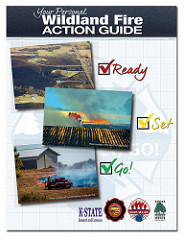Released: April 10, 2017
Ready, Set, Go! Wildland Fire Action Guide available now
Wildland Fire Action Guide provides tips on how to protect homes from wildfire

MANHATTAN, Kan. – Wildland fire is a real threat, as evidenced across the state this spring. The Kansas Forest Service has teamed up with K-State Research and Extension, the Office of the State Fire Marshal, and the International Association of Fire Chiefs to customize a Wildland Fire Action Guide specific to Kansas.
The guide was prepared by the IAFC’s Ready, Set, Go! Program, which works to develop and improve the dialogue between fire departments and the residents they serve. Launched nationally at the Wildland-Urban Interface Conference in 2011, the program helps fire departments teach individuals who live in high risk wildfire areas and the wildland-urban interface, how to best prepare themselves and their property against fire threats.
Engaging in this dialogue is particularly important because national studies have shown that firefighters are respected in their communities, and can project a trusted voice to the public preparedness appeal. They can also explain what fire resources are available during an event, and the role that individuals can play in preparedness and if called for, early evacuation, to increase the safety of residents and responding firefighters to a wildland fire.
The Ready, Set, Go! Program works in a complimentary and collaborative way with the Firewise Communities USA program and other existing wildland fire public education efforts. It amplifies their preparedness messages to better achieve the common goal of fire-adapted communities. In recent years, management of the Kansas prairie by naturally-occurring wildfires has given way to prescribed burning. However, data suggest that a majority of wildfires are now from human carelessness. An average of 110,000 acres are burned in accidental or uncontrolled fires every year in Kansas. The Kansas Forest Service is dedicated to helping landowners and managers continue to use fire as a tool to manage the land safely, while also providing homeowners assistance in protecting their homes if a wildfire should occur.
Paper copies of the Kansas Wildland Fire Action Guide are available at the Kansas Forest Service state office in Manhattan. The guide is also available online on the Kansas Forest Service fire prevention webpage: Kansasforests.org/fire_management/fireprevention.html. For more on the Ready, Set, Go! Program and its partners, visit WildlandfireRSG.org.
-30-
K‑State Research and Extension is a short name for the Kansas State University Agricultural Experiment Station and Cooperative Extension Service, a program designed to generate and distribute useful knowledge for the well‑being of Kansans. Supported by county, state, federal and private funds, the program has county Extension offices, experiment fields, area Extension offices and regional research centers statewide. Its headquarters is on the K‑State campus in Manhattan.
Story by:
Jennifer Williams
Communications Coordinator, Kansas Forest Service
jgwilliams@ksu.edu, or 785-532-3308
K-State Research and Extension
www.ksre.ksu.edu
About the Kansas Forest Service
The Kansas Forest Service is the nation’s fifth oldest state forestry agency. The agency serves rural landowners, communities, rural fire districts, forest and arboriculture industries, and citizens of the state through its Conservation Tree and Shrub Planting, Fire Management, Community Forestry, Rural Forestry, Marketing and Utilization, and Forest Health programs. The Kansas Forest Service state office is located in Manhattan, Kansas, just off the campus of Kansas State University. The Kansas Forest Service is housed as an independent agency within K-State Research and Extension. The agency receives its direction from a mission statement that reads: “Care of Natural Resources and Service to People through Forestry.”
